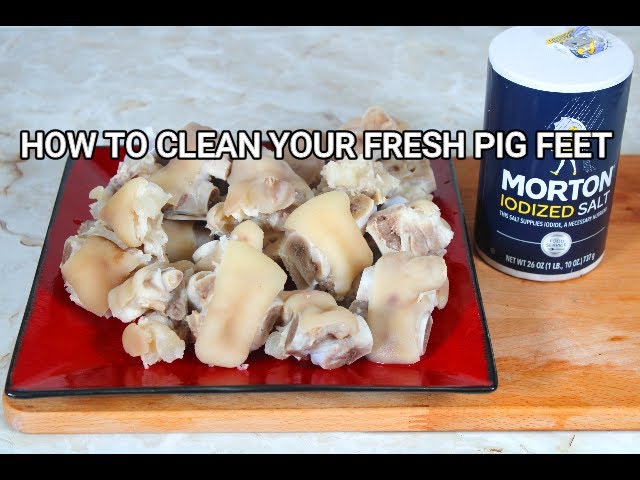This post aim to provide you guide to clean pigs feet before cooking. Cooking time for Pigs Feet is 15 minutes. If you need to clean them faster, put in a two hour cooking time. If you have a large cooking area, like in a restaurant, put the Pigs Feet in the oven at 350 degrees for three hours. You can then clean them using a cleaning supplies such as vinegar, detergent and water.

Here’s a step-by-step guide on how to clean pig’s feet properly:
- Purchase Fresh Pig’s Feet: Look for fresh pig’s feet from a trusted source, such as a reputable butcher or grocery store.
- Rinse with Cold Water: Start by rinsing the pig’s feet under cold running water to remove any visible dirt and debris.
- Scrub the Feet: Use a clean scrubbing brush or a scrubbing pad to gently scrub the surface of the pig’s feet. Pay close attention to the crevices and joints.
- Trim Excess Hair: Trim any excess hair on the feet using a sharp knife or kitchen shears.
- Soak in Water: Place the pig’s feet in a large bowl or container and cover them with cold water. Let them soak for at least 1-2 hours. Some people also add a little vinegar or lemon juice to the water to help with the cleaning process.
- Change the Water: After soaking, discard the water and refill the bowl with fresh water. Soak the pig’s feet for an additional 1-2 hours, changing the water again if needed.
- Final Rinse: Rinse the pig’s feet thoroughly under cold running water to remove any remaining impurities.
- Pat Dry: Use paper towels to pat the pig’s feet dry before using them in your chosen recipe.
Now your pig’s feet are cleaned and ready for cooking. Remember to follow any specific cooking instructions for your chosen recipe to ensure the best results.
How are pig’s feet eaten?
After rinsing them again, you can put them in a saucepan and cover them with salted water, along with carrots, celery, onions and aromatic herbs. As soon as they begin to boil, lower the flame and cook for at least three hours.
Where is the spare rib?
The spare rib is a piece of meat that runs along the chest on the one hand and the tenderloin, rack and loin on the other. This piece corresponds to the 15 ribs of the animal taken rather towards the bottom of the rib cage.
Can the strainer be eaten?
The strainer is a thin, peritoneal membrane that is used to hold together culinary preparations such as pipes and roasts. It is veined with lipids and often used in charcuterie.
How to put the strainer?
If you installed putty, press the strainer into the putty. Make sure the strainer stays in place.
How to salt pork?
We will rub the meat with a mixture of salt and herbs then press it in order to empty it of its blood (operation to be repeated throughout the duration of the salting) and then let it rest in a room at room temperature. It takes on average two days of salting per kilo of meat.
What is the difference between ribs and spare ribs?
The cross is different from the one called ribs or spareribs (ribs). Personally I prefer the ribs, after 6 hours on the barbecue, the piece becomes totally melted.
What is the difference between spare ribs and ribs?
The difference between ribs and spare ribs is that spare ribs are cut between the ribs and the pork belly fat. Once the ribs are perfectly cooked, the fat in the meat melts and coats the cartilage making the ribs incredibly tender and melt-in-the-mouth.
What is another name for spare ribs?
The ribs are a beautiful piece of meat to choose and keep with care. Depending on how you will use it, pork ribs can be chosen fresh, semi-salted or marinated.
How about crab’s leg? How to clean it properly before cooking?

Hello there! My name is Tristram Ortega and I am a professional chef with a passion for cooking. I work at a top-rated restaurant where I create delicious dishes every day, and I’m excited to share my tips and techniques with you. Through this blog, I share my favorite recipes, cooking hacks, and insights into the world of professional cooking. So let’s get cooking together!